
|
SUMMARY:
How to change jobs. How to get your dream job. How to switch careers. A key element of your success or failure in any of these is your personal value proposition. To help with your personal value prop, I leveraged Meclabs patented methodology, and sought advice from outside sources as well. |
Action Box: Let AI Agents Market For You
Join us on Tuesday, May 13th at 2 pm EDT to learn how to leverage a conversion-focused, agent-powered strike force in MeclabsAI. Register for MEC050: Let AI Agents Market For You today. There is no cost (from MeclabsAI, MarketingSherpa’s parent company).
I chose writing as my profession because I came of age in the late ‘90s. The news was filled with stories of factory workers in the United States who were laid off and became obsolete because of offshoring or automation. There whole careers gone – poof – in the blink of an eye.
I thought, ‘I need to pick a career wisely. I don’t want the same thing to happen to me.’ And so I became a writer.
I’m sure you know the rest of the story. In the 2000s, writing and other knowledge work started to get offshored thanks to sites like Elance and oDesk along with global companies that shifted more marketing tasks overseas. And today, automation has come for the writers and other knowledge workers in the form of artificial intelligence.
So what do we do?
Here’s where marketers have a leg up over other knowledge workers in my opinion, but sometimes we overlook our skills in this area. We need to see ourselves as the product we’re marketing.
This can be hard for many reasons. Not the least of which is that we don’t have the outside perspective that we do for a company (AI can help with this).
And no, I’m not just talking about personal branding. It does have its role in theory, but I worry in practice it just becomes bragging a lot on social media.
I think a better approach is taking the same value proposition framework we use for a business and applying it to ourselves. Before I ask you to start answering questions, let me answer one for you.
A personal value proposition is a clear, concise statement that explains the unique benefits you bring to the table. It answers the key question: "If I'm the ideal candidate or partner, why should they choose me?" Your value prop combines your skills, experiences, and intrinsic qualities to set you apart from others.
In this article, we’ll go step-by-step through the same Meclabs value proposition methodology used on businesses large and small and see how you can apply that methodology to yourself. I also brought in some perspectives from outside sources.
Before you get the right answer, you need to nail down the right question.
Ultimately, you will probably want more than one, because you will have many conversion goals or people to reach out to. So start with the one that is most valuable to you right now, and create more in the future.
Here is the framework for your personal value proposition question, based on Meclabs methodology: ‘If I am [your ideal customer,] why should I [action you want them to take] with you instead of [your competitors]?’
“Separate the means from the end. Focus on the customer’s experience of the value,” Flint McGlaughlin, CEO, MeclabsAI, teaches in Value Proposition Power: 3 ways to intensify the force of your value proposition (MeclabsAI is the parent company of MarketingSherpa).
The value proposition methodology works by helping companies engage in customer-first marketing. And you need to do the same thing with your personal value prop. As marketers we think we’re empathetic. But sometimes we really need to force the issue.
A powerful value proposition is focused on the ‘other’; not on ourself. So think – who are you trying to help? Who is your ‘customer?’
It could be your potential employer. Or you could get even more specific, maybe it’s ‘a recruiter for Teva Pharmaceuticals.’
As we know from marketing, if we want to get results, we need to be clear on the conversion objective.
So with this personal value prop, what do you want? What do you need
I see plenty of posts on LinkedIn with the generic, ‘Hi everyone. I am seeking a new opportunity and would appreciate your support.’
My heart goes out to these people. But…what exactly am I supposed to do? I want to help, but…oh wait, I’m getting a Slack message about an urgent task. And my Outlook just popped up with a meeting I have to be in. And…where was I?
Don’t make them think. They’re too busy. Tell them exactly what you need.
So how’s about… ‘Hi SaaS friends, I'm now seeking a new opportunity as a Marketing Manager in a fast-paced environment, where I can leverage my skills in SEO, data analytics, and digital campaign management. If you no of such an opportunity in your network, could you give your contact a link to my LinkedIn bio.’
By nailing your personal value prop first, your LinkedIn messages (and all your other communication) will be more effective.
When coming up with your conversion ask, consider the cost as well. The lower the cost, the more likely they are to convert. It’s easy to overlook for a personal value proposition.
While you likely won’t be asking for material cost (like money), you will be asking for mental cost.
How can you reduce mental cost? For example, if you’re asking for a letter of recommendation, you could include a reminder of several key projects you worked on together that were successful.
Another word we might use is – competitors.
Traditionally this would have been your human competition, like ‘any other candidate’ or ‘any other consultant.’
But frankly these days AI is one. Because right now artificial intelligence is both your friend (more on that in a bit) and your foe.
“For those worried about AI displacement, I suggest doing a ‘capability audit’ – chart your skills on a scale from ‘easily automated’ to ‘distinctly human,’” said Sheraz Ali, founder, HARO Links Builder.
If you’re familiar with Meclabs, you know that we have a series of patented heuristics (thought tools) to help you with your marketing. Here’s a quick look at our key value proposition heuristic.
Creative Sample #1: The Meclabs Net Value Force heuristic

We already addressed the cost force (Cf) when considering the material (Mt) and mental (Mn) costs of your conversion ask. No, here are some questions to help you dive into your past and craft your personal value proposition, addressing each element of the heuristic.
Appeal (Ap) is a key element in the value force (Vf) of your personal value proposition. Appeal is connecting your value to others, getting them to say ‘yes, I want this now,’ according to Meclabs’ 8 Micro-Yes Architecture.
“One of my clients initially struggled to thrive in traditional corporate settings where their [neuro]divergent thinking was misunderstood. By clarifying their personal value around ‘adaptive innovation’ (the ability to spot gaps, pivot strategies quickly, and create intuitive solutions), they repositioned themselves from a 'nontraditional candidate' to a strategic innovation consultant,” said Blondy F. Moore, Life & Success Coach, Moore Success Group.
Amplify appeal by highlighting benefits and outcomes, not just features. Focus on the transformative impact you deliver.
In many fields, artificial intelligence (your ability to tame and master it) may be a key element of appeal today that didn’t matter at all that last time you were looking for a job five years ago.
In addition to Question #4, here are other questions that may help:
Exclusivity (Ex) is your combination of experiences and intrinsic qualities that sets you apart, getting people to say ‘yes, I want this from you’ as opposed to just wanting what you offer in general (but being able to get it from many other places).
When you’re measuring exclusivity, you’re looking at how distinct and unique your offer is when compared to alternatives (which you identified in Question #3 above).
Highlight your unique mix of skills. Emphasize what makes you different – specific skills, experience, or a unique perspective that is hard to find elsewhere.
“The bigger game is branding yourself as a category of one. If your LinkedIn headline could belong to anyone else, you're not going to make it,” advised Lars Nyman, founder, Nyman Media.
In addition to Question #5, here are other questions that may help:
For your value to have force, and for the cost to have (reduced) force, your ideal customer needs to accept (Ac) what you’re communicating. A key element of acceptance is Credibility (Cr) – how much trust and confidence you inspire in your target audience. Getting your target audience to think ‘Yes, I believe.’
I’ve done more than a hundred job interviews in my career, and I find credibility often lacking. Everyone makes claims in these job interviews (‘tis the very rare candidate who would claim to not be detail-oriented or reliable or able to hit deadlines), but when questioned deeper on a claim many had nothing to add.
Another challenge I’ve seen is claims of skills on a resume that are not backed up by fact. Here’s a real interaction I’ve had in an interview:
A more credible way to communicate technical skills on a resume would be showing a scale of 1 to 5 – differentiating tools you are merely familiar with from tech you are truly proficient in.
Use credentials, accomplishments, and real-world examples to back up your claims. This will be especially important if you’re making any claims about your AI abilities. Anytime a new revolution occurs, the hype always precedes the reality. Your ideal customer will surely be judging the veracity of any claims you make regarding artificial intelligence.
In addition to Question #6, here are other questions that may help:
All is for naught if your ideal customers does not understand what you’re saying. That is why Clarity (Cl) – how clearly you communicate your expertise and skills – is also key to acceptance.
“You must weaponize specificity, meaning ‘I'm a marketing strategist’ is dead on arrival. ‘I help SaaS companies under $5M ARR triple inbound revenue using AI-enhanced funnel design’ – now we're talking,” Nyman said.
Ensure your statement is simple, direct, and free from buzzwords. Use industry terms only to help clarify, do not overuse them to simply appear smart.
In addition to Question #7, here are other questions that may help:
Up until this point, we talked about artificial intelligence as your competition. We also discussed that your personal value proposition may need to address what benefits you can bring to your ideal customer with AI (appeal and credibility), a factor that likely wasn’t an issue the last time you were in the job market.
But AI isn’t just your competitor, AI isn’t just your proof point, it can also be your helper. It’s almost a homeopathic approach – the cause can also be the cure.
Flint McGlaughlin, who holds the patent for Meclabs methodology, built a Personal Value Prop Analyzer app in MeclabsAI. You simply paste in the content from your LinkedIn profile.
You can try it yourself in the live, interactive training MEC050: Let AI Agents Market For You on Tuesday, May 13th at 2pm EDT. There is no cost to attend.
The app can help you understand how well you are communicating a personal value prop on your LinkedIn profile, and can give you:
To show you a specific example, I pasted my own LinkedIn profile into the Personal Value Prop Analyzer in MeclabsAI. You can click here to see the analysis it gave me.
Ultimately, this process should be fun and empowering. It’s your change to look back through your career (and life), and use the skills and wisdom you have accumulated to power your next move.
If you’re having a hard time reflecting on your career, listen to an episode or two of How I Made It In Marketing. Hearing your peers reflect on their journey might spark memories about your own experiences.
This article was originally distributed through the MarketingSherpa email newsletter.
How to use a value proposition beyond the main business value prop (3 examples)
Get Better Business Results With a Skillfully Applied Customer-first Marketing Strategy

The customer-first approach of MarketingSherpa’s agency services can help you build the most effective strategy to serve customers and improve results, and then implement it across every customer touchpoint.
Get More Info >MECLABS AI
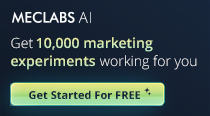
Get headlines, value prop, competitive analysis, and more.
Use the AI for FREE (for now) >Marketer Vs Machine
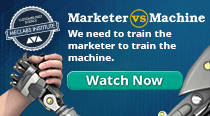
Marketer Vs Machine: We need to train the marketer to train the machine.
Watch Now >Live, Interactive Event

Join Flint McGlaughlin for Design Your Offer on May 22nd at 1 pm ET. You’ll learn proven strategies that drive real business results.
Get Your Scholarship >Free Marketing Course
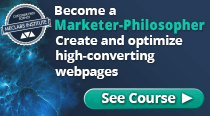
Become a Marketer-Philosopher: Create and optimize high-converting webpages (with this free online marketing course)
See Course >Project and Ideas Pitch Template
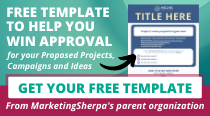
A free template to help you win approval for your proposed projects and campaigns
Get the Template >Six Quick CTA checklists
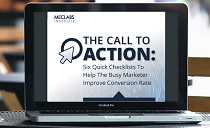
These CTA checklists are specifically designed for your team — something practical to hold up against your CTAs to help the time-pressed marketer quickly consider the customer psychology of your “asks” and how you can improve them.
Get the Checklists >Infographic: How to Create a Model of Your Customer’s Mind
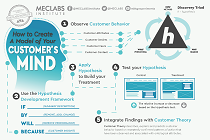
You need a repeatable methodology focused on building your organization’s customer wisdom throughout your campaigns and websites. This infographic can get you started.
Get the Infographic >Infographic: 21 Psychological Elements that Power Effective Web Design
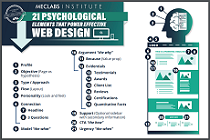
To build an effective page from scratch, you need to begin with the psychology of your customer. This infographic can get you started.
Get the Infographic >Receive the latest case studies and data on email, lead gen, and social media along with MarketingSherpa updates and promotions.